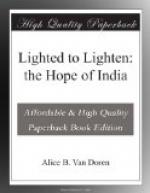[Illustration: BABY ON SCALES]
Then came the suggestion of an American college, and Dora started off on a voyage of discovery that must have been epoch-making in her life. It is, as I have said, a far cry from Lahore to South Hadley. It means not only physical acclimatization, but far more delicate adjustments of the mind and spirit. Many a missionary, going back and forth at intervals of five or seven years, could tell you of the periods of strain and stress that those migrations bring. How much more for a girl still in her teens! New conventions, new liberties, new reserves—it was young David going forth in Saul’s untried armor. Of spiritual loneliness too, she could tell much, for to the Eastern girl, always untrammelled in her expression of religious emotion, our Western restraint is an incomprehensible thing. “I was lonely,” says Miss Maya Das, “and then after a time I reacted to my environment and put on a reserve that was even greater than theirs.”
So six years passed—one at Northfield, four at Mt. Holyoke, and one at the Y.W.C.A. Training School in New York. Girls of that generation at Mt. Holyoke will not forget their Indian fellow student who “starred” in Shakespearian roles and brought a new Oriental atmosphere to the pages of the college magazine. Six years, and then the return to India, and another period of adjustment scarcely less difficult than the first. That was in 1910, and the years since have seen Miss Maya Das in various capacities. First as lecturer, and then as acting principal of Kinnaird College at Lahore, she passed on to girls of her own Province something of Mt. Holyoke’s gifts to her. Now in Calcutta, she is Associate National Secretary of the Y.W.C.A.
It was in Calcutta that I met Miss Maya Das, and that she left me with two outstanding impressions. The first is that of force and initiative unusual in an Indian woman. How much of this is due to her American education, how much to her far-northern home and ancestry, is difficult to say. Whatever the cause, one feels in her resource and executive ability. In that city of purdah women, she moves about with the freedom and dignity of a European and is received with respect and affection.
The second characteristic which strikes one is the fact that Miss Maya Das has remained Indian. One can name various Indian men and some women who have become so denationalized by foreign education that “home” is to them the land beyond the water, and understanding of their own people has lessened to the vanishing point. That Miss Maya Das is still essentially Indian is shown by such outward token as that of dropping her first name, which is English, and choosing to be known by her Indian name of Mohini, and also by adherence to distinctively Indian dress, even to the embroidered Panjabi slippers. What matters more is the inward habit of mind of which these are mere external expressions.




